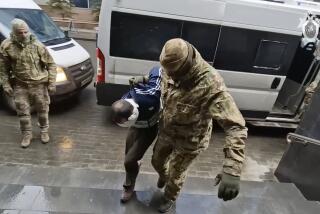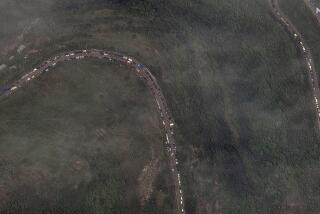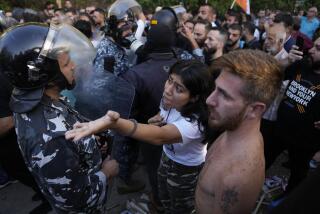After Soviets, Silk Road Nations Look to a More Glorious Past
- Share via
SAMARKAND, Uzbekistan — A gigantic statue of Tamerlane gazes over this fabled Silk Road city, marking the fierce conqueror’s transformation into national hero after decades of abuse.
“He was the leader of the nation. He’s our pride,” said Rakhmatulla Sagatov, an Uzbek tourist admiring the 6-year-old sculpture of the 14th century Muslim ruler, who used the riches of vanquished lands to build a glorious capital here. “In Soviet times they were calling people like Tamerlane ‘thugs’ and ‘cutthroats.’ ”
Uzbekistan and other Central Asian nations that emerged from the Soviet collapse in 1991 are enjoying a cultural renaissance. These lands, best known for the camel caravans that once carried Chinese silk, spices and tea to Europe, are racing to build national identities based on their heroes, monuments, traditions and myths.
The Sept. 11 attacks on the United States have galvanized a Western presence in this region of about 58 million people, with Americans involved in security, trade and education as never before. An Islamic resurgence is also underway, but with strict controls imposed by authoritarian leaders, former Communists who fear that their secular states -- and personal rule -- could be swept away.
“The Silk Road, as the route between Europe and China, wasn’t too important for probably a lot of centuries,” said John Dreier, acting president of the American University-Central Asia, a U.S. government-supported school in Kyrgyzstan. “But now, particularly with the events of 9/11, this part of the world has become far more interesting, far more noticed and on the map again.”
This “lost heart of Asia,” as one travel book calls it, is now the stage for activity as varied as a tour by cellist Yo-Yo Ma and geopolitical jockeying, Dreier noted.
Washington used military bases here to help take down the Taliban regime and fight its Al Qaeda allies in adjacent Afghanistan. The U.S. is also keen on access to Central Asian oil and gas. Russia still considers Central Asia its backyard. China also seeks energy supplies and wants to head off any spread of Islamic radicalism.
The five Central Asian nations that emerged from the ashes of the Soviet Union -- Kazakhstan, Kyrgyzstan, Tajikistan, Turkmenistan and Uzbekistan -- are all predominantly Muslim.
Millions of Russians and other ethnic Europeans who were born here or came during Soviet times have left because of economic hardship. But for many Central Asians, independence was its own reward.
“We’re Uzbeks. The second part of the word means ‘master.’ That means master of your life, master of yourself,” said Pardaboy Shodiev, 69, a farmer in a village 80 miles from Samarkand. “After independence, Uzbeks have become ‘beks’ in the proper sense of the word.”
These lands sweep from the Caspian Sea and the deserts of Turkmenistan and Uzbekistan to the snow-capped peaks of Kyrgyzstan and Tajikistan. Kazakhstan, by far the largest of the five, extends from its arid southwest to upland steppes and mountains bordering Siberia and China.
Each country is ruled by a president from its dominant ethnic group.
Independence has led to the resurgence of Navruz, the Central Asian New Year celebrated with feasting at the beginning of spring, said Shodiev. “In Soviet times people would still cook this meal, but they’d do it secretly because it was considered a banned religious practice.”
In Kyrgyzstan, a country whose people have nomadic roots, post-Soviet authorities turned again to the oral epic of Manas, the legendary founder of the Kyrgyz nation. The tradition of reciting the epic weakened during Soviet times but never died out.
It now inspires television shows and novels, and there are special schools to preserve the oral tradition. Kyrgyz President Askar A. Akayev held an international festival to honor the epic’s 1,000th year in 1995.
U.S. troops sent to Kyrgyzstan to support operations in Afghanistan after the Sept. 11 attacks are based at Manas airport, which serves the capital, Bishkek. U.S. forces are also stationed at an Uzbek air base.
The last Communist bosses from Soviet times remain in power in all but Tajikistan, where President Emamali Rakhmonov, who used to head a collective farm, has ruled since 1992. Kyrgyzstan is the most liberal and open of these states, but it has drawn criticism for moves against opposition parties and independent media.
Islamic fundamentalists and democrats alike view most or all of these governments as repressive. Yet many ordinary citizens appear happy that at least they are being ruled by someone of their own nationality.
Gulmira Izbanova, 32, teaches Kazakh music at an elementary school in Almaty, Kazakhstan’s biggest city, which boasts broad, tree-lined streets and boutiques that give it a European feel. But she returns on weekends to the rural home of her husband’s parents, where a yurt serves as kitchen and dining room during the warmer months.
For the Kazakhs and the Kyrgyz, the pressed-wool yurt -- often richly furnished with tapestries, carpets and carved wooden chests -- remains a beloved symbol. The Kazakhs’ shift to a more settled lifestyle and a recent oil boom that has brought billions of dollars, are “obviously” good things, Izbanova said, but those changes don’t mean traditions will disappear.
For the farm-and-city-based Uzbek and Tajik civilizations, the past also resonates in physical reminders of greatness.
“We call Samarkand ‘the navel of the Silk Road.’ We’re right in the middle,” said Juraqul Mansurov, 57, an Uzbek who sells ice cream and cigarettes in the city’s Registan, a spectacular complex of three blue-tile-and-dome former madrasas, or religious schools. “It was like the hub of the universe in the past.”
The madrasas -- the oldest completed in 1420 under Tamerlane’s grandson -- were shut down by the Communists.
Uzbekistan had only 80 mosques and two religious schools at the end of the Soviet era. It now has 2,500 mosques and about a dozen religious schools.
The government of President Islam Karimov struggles to keep this growth of Islam within approved channels. Its greatest fear appears to be Hizb ut-Tahrir, or Party of Liberation, which calls for an Islamic state throughout Central Asia. Uzbek authorities have said that people with a background in Hizb ut-Tahrir were among those responsible for suicide bombings and shootouts with police in late March that left 47 people dead.
Since the Soviet collapse, many new mosques have been constructed in all the Central Asian states, often with money from Muslim countries such as Saudi Arabia or Qatar.
The United States is working to assist the media and set up institutions such as the American University-Central Asia, which receives support from the U.S. government and financier George Soros. This year it had 1,100 students from 27 countries, more than 90% from Central Asia.
New international ties are not limited to the urban elite. Marhamat Shodieva, the Uzbek farmer’s wife, said one of their daughters is studying English from Americans in the nearby city of Jizzakh.
The Shodievs believe in the easygoing form of Islam subscribed to by most people in Central Asia, where hospitality is a required virtue and a secular state is welcomed.
Pardaboy Shodiev was comfortable enough to take off his skullcap, point to four embroidered designs on the top, and joke that they stood for “Marx, Engels, Lenin and Stalin” -- the great icons of Soviet communism.
At the end of a meal with strangers who had appeared unannounced at his farmyard gate, he asked all present to join in prayer. “I ask Allah to give us this good food always,” he said. “And may foreigners come here more often, so there will be no war. May our country live in peace.”
More to Read
Sign up for Essential California
The most important California stories and recommendations in your inbox every morning.
You may occasionally receive promotional content from the Los Angeles Times.













